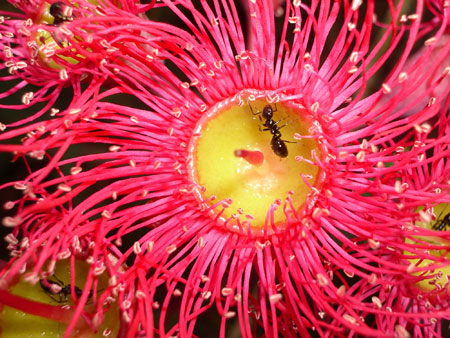For many Australians, the Eucalypt is the quintessential Australian plant. Spread across the country, there are almost 700 different varieties of Eucalypt that are endemic to Australia, ranging from small shrubs to large trees that grow up to 100 metres in height.
Eucalypts are part of the Myrtaceae family, which also includes Bottlebrushes (Callistemon) and Paper Barks (Melaleuca), which, like the Eucalypt, has aromatic foliage. The two largest varieties of Eucalypt include the Tasmanian Blue Gum (Eucalyptus globulus), which is also the floral emblem of the isle state, and the Mountain Ash (Eucalyptus regnans), which is the largest of all the Eucalypt varieties, growing to staggering 70 -100 metres tall.
The leaves of the Eucalypt are highly sought after for their oil, the medicinal properties of which are used for disinfecting both externally and in foods such as throat lozenges. Both the leaves and flowers of the Eucalypt are widely used in cut flower arrangements. The flowers of the Eucalypt don't have petals, but instead get their colour from hundreds of tiny stamen. These attract birdlife, which feed on the flower's nectar and help it to pollinate.
These delicate, whispy flowers have also become popular in flower arrnagements because of their variety of colours, such as the bright orange of Orange Splendour (Corymbia ficifolia), the bright, showy, yellow flowers of Melbourne's Yellow Gum (Eucalyptus leucoxylon ssp. Connata), and the creamy white of the White Box (Eucalyptus Albens).
One of the most popular varieties of Eucalypt used for cut flowers is the Rosea (Eucalyptus leucoxylon var. megalocarpa). This grafted cultivar has deep scarlet flowers that bloom for an extensive period, usually from April until October, making it an economical choice for both flower nurseries and gardeners alike.
Because of the sheer variety of Eucalypts, it is best to find one that is native to your area if you wish to grow one yourself. This is important for a few reasons. Firstly, the tree should prove more suited to both the climate and soil conditions of your garden, and secondly, it will help to support native wildlife, providing a native habitat for birds and small animals. Just be sure to tae note of the tree's scientific name when looking into the right variety to grow and check its maximum growth height, to be sure it's right for your garden.
The flowers of the Eucalypt make a wonderful addition to many cut floral arrangements, and because of their long bloom time, they are easy to find in stock at most times.
